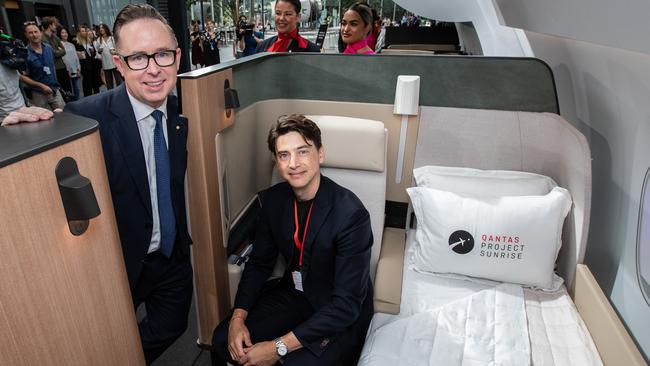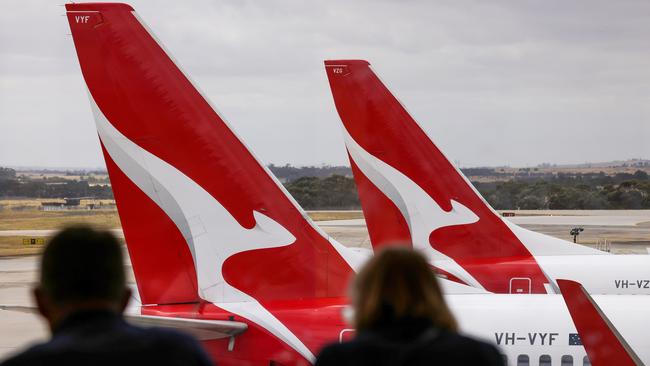
The December record half profit of $1.43bn from a loss of $1.28bn this time last year, combined with surging sales, is a remarkable turnaround and draws a line under the string of massive losses through the dark Covid-19 years.
And with the prospect of a brand-new Airbus aircraft arriving every three weeks for the next two years; new routes; newly-designed business and first class seats; and $100m to be spent on upgraded lounges, Joyce’s Qantas is on a very different flight path from this time last year.
Cursed by customers but loved by investors, Joyce has steered the airline all the way through the price wars of the pre-Covid-19 era and then through the Covid-19 pandemic.
Few really appreciate how close Qantas came to collapsing amid groundings and border closures. At one point, the airline had only enough cash to survive for just 11 weeks.
Joyce acknowledges it’s been “a long and frankly difficult journey” to get where the airline is today. He adds it has been customers who have helped get through a rocky 12 months of recovery, a period marred by flight cancellations and missing baggage and higher prices.

Last year was all about rebuilding the airline almost from the ground up and in the process giving some modest returns back to shareholders. He has also been wooing back staff with generous bonus schemes. But Joyce has nowhere to hide from today’s record top line numbers and needs to show he is entering a new phase: Investing in customers.
The Qantas boss gives ground saying it has been a tough time for passengers who “stuck with us even when we were a long way from delivering the service that they normally expect”.
The airline boss admits at times the restart effort was too ambitious, with huge demand met with waves of Covid-19 illnesses while supply-chain squeeze was grounding aircraft. All up this was badly undermining the customer experience.
But now he says the additional cash pumping through the airline and a more consistent operating rhythm means he can spend funds on passengers again.
He points out this has already been happening with Qantas, the most on-time of the major domestic airlines for five months in a row. And more flights are being put on as staff and new aircraft become available. Closely watched customer satisfaction ratings are climbing again, while forward bookings remain strong. And of course the new planes are arriving.
Exit row
Now into his 13th year as chief executive, Joyce expects to remain in place until at least the end of this calendar year. This puts easily him as the longest-serving bosses of a top 30 company.
In the background, the Qantas board chaired by Richard Goyder has succession planning underway, reviewing internal contenders as well as looking outside the company for the right fit. It is understood Joyce hasn’t yet held the retirement conversation with Goyder, but remains energised in the post-pandemic airline era.
Even after all these years, Joyce’s ruthless instincts haven’t softened. With arch rival Virgin preparing itself for an early return to the ASX after being revived from administration, Joyce has sought to spoil the party by flooding the market with more than 10 million ultra-cheap fares across Qantas’ Jetstar network. This is the time Virgin should be generating its best financial numbers to get the best valuation, and now it’s being forced to compete at the discount end while Joyce gets to protect his margins in his premium Qantas brand.
And margins (the measure of profit) is where the magic has happened in the latest six months. Those high-priced seats that travellers are copping are a result of consistently strong pent-up demand for travel while the network rebuilt have remained at limited capacity.

Qantas’ domestic business, the engine of the company, returned margins of a whopping 21.6 per cent in the December half. In the period before Covid-19, these were closer to 14 per cent. International – where capacity remains restrained – is posting margins above 12 per cent. Before Covid-19, international profit margins barely beat 5 per cent. Helping the boost across the company is the massive $1bn cost cutting drive launched through Covid-19, which is on track to deliver more savings this financial year and provide addition leverage through the recovery.
Joyce points out there’s a competitive market fast returning to aviation – particularly in domestic with new players like Bonza and Rex as well as Virgin offering its own rapid airfare sales. He points out ticket prices are moderating as capacity is added back. And with low ticket prices such as Jetstar million seats offer, it shows competition is at work.
“We have more competition domestically than we’ve ever had … and that’s the big thing that moderates airfares going forward”. This outlook was enough to spook the market, sending Qantas’ shares 6.8 per cent lower on Thursday.
Still vulnerable
Despite Qantas’ impressive recovery, Joyce has a major vulnerability.
The Qantas balance sheet remains wafer thin, leaving it exposed to any unforeseen shocks. At the end of December, Qantas’ net assets were just $16m – that’s million. Four years ago, it was closer to $4bn, underscoring just how tough the blows were through Covid-19. And with heavy capex demands including spending of nearly $2.7bn this year, the airline will need several years of current cashflow to get back to normal.
Air New Zealand, which also released first half accounts on Thursday, had net assets of $NZ1.85bn ($1.69bn) at the end of December. The New Zealand carrier delivered a similar rapid-recovery story, posting first half earnings of $NZ299m from a loss last year of $NZ367m as sales surged.
For Qantas, nearly $3bn in accumulated losses means it could be at least until September next year before the Australian airline declares its first post-Covid-19 dividend. However, Joyce has been doing what he can to keep shareholders onside through a string of share buybacks. The latest $500m buyback outlined Thursday takes total returns to up to $900m since the second half of last year.
Medibank’s lessons
For Medibank boss David Koczkar it’s all about looking ahead after a horror end to the year for his health insurer when a devastating cyber attack saw some deeply personal customer information stolen and leaked online.
Customers were rightly angry their details could have been accessed in such a way and even after the hackers have moved on policyholders are demanding answers as to what went wrong and assurances that it won’t happen again. However the numbers show that on the whole they are sticking by Medibank. Nearly 14,000 left in the weeks following the October attack, but this quickly stabilised by the end of December. Indeed the insurer is now seeing net customer numbers starting to lift again while those cancelling no longer report cybercrime as the top reason for leaving with the shift now moving to cost of living. However Koczkar says it is still early days.

Telco Optus, last year’s other high profile cyber attack target, also reported a similar experience with customer losses in the thousands lasting about two to three months before growth slowly returned.
At one point during the crisis, Medibank was facing as much as 80 million hacking attempts a day as news of the attack was going around the world. Before the cyber attack it was running about 10 million a day and now it is averaging 18 million. This still runs at nearly 600 million a month which is on par with a big four bank, and by the law of averages one will eventually slip past.
“There’s no doubt in my mind that we are in an arms race on cybercrime and the rules are changing every day,” Koczkar says. “That’s a new world we are operating in.”
The health insurance boss gave some more details around the “how” it happened with the affair still under investigation. The initial breach came from a Medibank username and password used by a third party IT service provider that was stolen and used across the network. These were used by the hacker to gain access to the network and gradually collect more usernames and passwords to open up more systems. Koczkar is awaiting recommendations for the investigation but in the meantime has increased the cyber training of all staff and has spent big on bolstering tech defences.
Medibank is counting the cost and the first set of accounts since the attack shows the insurer is expected to be hit with more than $45m for cyber crime costs, including shutting down and rebuilding computer networks and additional support and communication services for customers. All along Koczkar held out refusing to pay a ransom to the cyber crooks – thought to be Russian – and eventually they lost patience and moved on.
Koczkar acknowledges it was a tough time for the company and all of its staff but Medibank “will emerge stronger” from the period.

Now the focus is on rebuilding momentum again with customers with inflation and higher interest rates putting household budgets under pressure. Koczkar says this average year’s premium increase of 2.9 per cent was the lowest rise in more than two decades. The increase was also deferred two months, and this is in addition to more than $200m in cash refunds to be sent to customers in May. Through all this Medibank still posted a 7.4 per cent jump in December half operating profit to $308m, helped by strong customer growth before the attack. Medibank is also sending cash back to shareholders, by boosting dividends slightly to 6.3 cents a share.
johnstone@theaustralian.com.au








Alan Joyce moves a step closer to leaving Qantas on a financial high and can thank Australian travellers who helped fund one of the fastest global airline turnarounds since the pandemic. Now it is time to start delivering for them again.